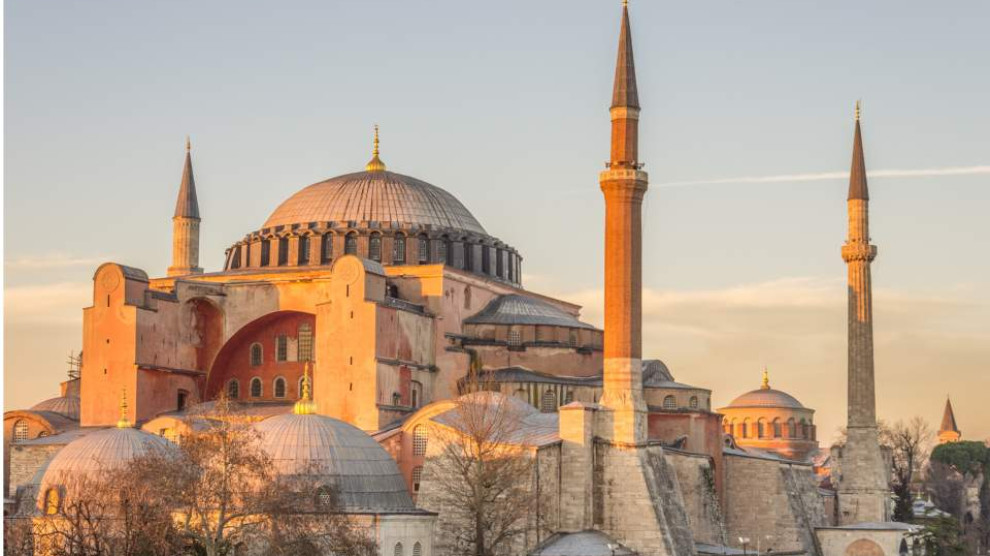In open letter, academics warn over status of Hagia Sophia
“Hagia Sophia is too beautiful a monument and too precious a historical document to serve as a pawn in regional politics,” say academics.
“Hagia Sophia is too beautiful a monument and too precious a historical document to serve as a pawn in regional politics,” say academics.

Dozens of scholars of Byzantine and Ottoman art and culture have signed an open letter to express their concern ahead of a decision Thursday by the Turkish Council of State regarding the status of Hagia Sophia in Istanbul.
In the letter, the academics warn against the “careless treatment” of the city’s former Byzantine cathedral, saying that “historical and archaeological evidence could be damaged, and works of art concealed.”
Below is the full letter.
Dear colleagues,
On July 2, the Turkish Council of State will announce a decision regarding the status of Hagia Sophia in Istanbul. Multiple learned organizations have expressed concern regarding this news. As scholars of Byzantine and Ottoman art and culture, we write now, not to protest an action that has not yet been taken, but to clarify the concern that we share, on the basis of the information currently available to us.
In our opinion, the central question is not, “Should Hagia Sophia be a museum or a mosque?” The central question is rather, “How can we best care for Hagia Sophia?” In other words, we draw a distinction between function and stewardship. We are concerned that the ongoing dispute over function hinders the development of a management strategy commensurate to the scale of the challenges: preservation of the historical fabric and continued visibility of the works of art of all periods, Byzantine and Ottoman; responsible management of mass tourism; and protection against the threat of earthquake.
From 1453 until 1934, Hagia Sophia served as a congregational mosque, and was administered by a pious endowment (vakıf). After the declaration of the Turkish Republic (1923), jurisdiction over all such entities was assumed by a new government ministry, the Directorate General of Foundations. Hagia Sophia continued in use as a mosque throughout the 1920s, but in 1931 restorers began to reveal the mosaics of the interior. The spectacular success of their work convinced the Turkish Council of Ministers (1934) to transfer jurisdiction over the building from the Directorate General of Foundations to the Ministry of Education.
This change in jurisdiction coincided with a change in function, through which the building was closed to worship. Both jurisdiction and function, however, have continued to evolve. Hagia Sophia is today administered by the Ministry of Culture and Tourism, as the administrative successor to the Ministry of Education. At the same time, the function of the building has expanded to include increasingly visible expressions of Muslim piety. Since 1991, there has been a room dedicated to Muslim prayer within the complex. Since 2016, Hagia Sophia has been served by a full-time imam, the call to prayer has sounded from the minarets, and Qur’anic readings and prayers have taken place within during the annual observation of Laylat al-Qadr.
Thus, in a certain sense, Hagia Sophia is currently functioning as both a museum and a mosque. As far as we are aware, the expansion of this latter function has not resulted in damage to the building or obstruction of its works of art. The Ministry of Culture and Tourism remains a responsible steward.
At the same time, prominent voices in Turkey have long argued that the transfer of jurisdiction to the Ministry was unlawful. They claim that the Turkish state did not have the right to “secularize” Hagia Sophia in 1934, since pious endowments are perpetual and inviolable. According to this argument, the rightful custodian of the building is the Directorate General of Foundations.
In recent years, the Directorate General has assumed control of other Byzantine monuments and reopened them to Muslim worship. One prominent example is another Hagia Sophia, this one in Trabzon on the Black Sea, whose proper administration has been contested since 2013. An effort to re-open the building to Muslim prayer included construction of an elaborate set of screens to obscure the Byzantine frescoes. Less publicized, but of more lasting harm, was the campaign of restoration carried out by the Directorate General on Hagia Sophia in Vize (Thrace) in 2006, which resulted in substantial damage to the historical fabric of the building.
Our concern is that the current conflict, until now only a “war of words,” could result in similarly careless treatment of Hagia Sophia in Istanbul: that historical and archaeological evidence could be damaged, and works of art concealed.
Hagia Sophia is too beautiful a monument and too precious a historical document to serve as a pawn in regional politics. Successive Byzantine, Ottoman, and Turkish governments have protected it against the ravages of time and thus maintained its significance not only for themselves, but also for those to come in the future — including all of us. It is a matter of vital concern to us as scholars of Byzantine and Ottoman art and culture that the current Turkish government continue this tradition of responsible stewardship.”
[To sign the letter, click here.